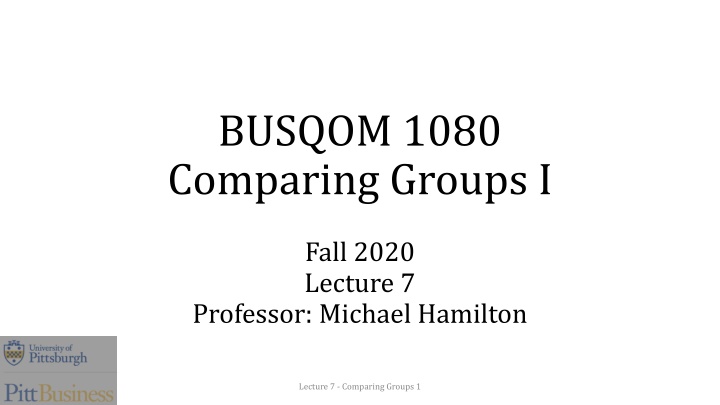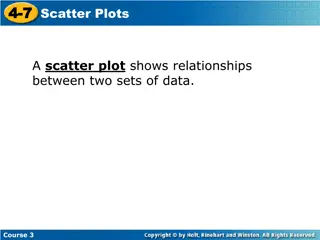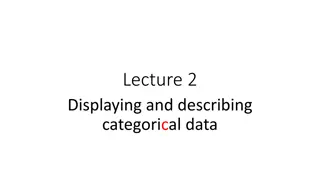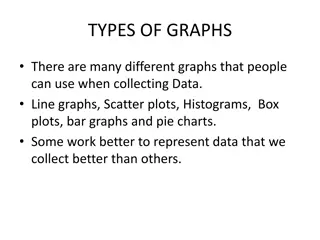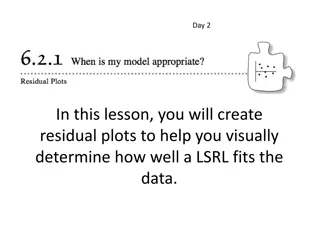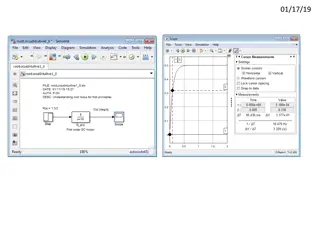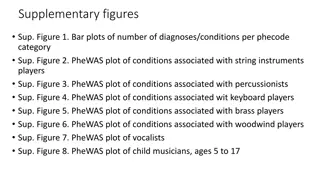Comparing Groups & Summary Plots in Categorical Data Analysis
In this lecture, Professor Michael Hamilton covers methods for comparing groups and generating summary plots in categorical data analysis. Key topics include hypothesis testing, Chi-Squared test, Binomial test, and Test of Equal Proportions. Examples demonstrate how to utilize R for creating tables, computing proportions, and comparing groups using summary statistics and plots. Gain insights on understanding categorical variables and interpreting relationships between different groups based on airline and flight data analysis.
Download Presentation

Please find below an Image/Link to download the presentation.
The content on the website is provided AS IS for your information and personal use only. It may not be sold, licensed, or shared on other websites without obtaining consent from the author.If you encounter any issues during the download, it is possible that the publisher has removed the file from their server.
You are allowed to download the files provided on this website for personal or commercial use, subject to the condition that they are used lawfully. All files are the property of their respective owners.
The content on the website is provided AS IS for your information and personal use only. It may not be sold, licensed, or shared on other websites without obtaining consent from the author.
E N D
Presentation Transcript
BUSQOM 1080 Comparing Groups I Fall 2020 Lecture 7 Professor: Michael Hamilton Lecture 7 - Comparing Groups 1
Lecture Summary 1. Recap of previous summary methods on categorical data. 2. Making tables in R using table(). [5 Mins] 3. Fundamentals of hypothesis testing. [10 Mins] 4. Review the Chi-Squared Test. [5-10 Mins] Example 1: Chi-Squared test on installed data using chisq.test(), 5. Review the Binomial Test. [5 Mins] Example 2: Binomial test on installed data using binom.test() 6. Review the Test of Equal Proportions. [5 Mins] Example 3: Test of Equal Proportions using prop.test() Lecture 7 - Comparing Groups 1 2
Topic: Understanding Categorical Vars. We learned some commands to get counts and proportions. Example: flight_data = read.table("RegionEx_Data.txt", header = T, sep = "\t") > airline = flight_data$Airline > airline[1:10] [1] RegionEx RegionEx RegionEx RegionEx We can count the number of observations using length() length(airline) [1] 360 Compute proportions by summing logicals sum(airline == "MDA")/length(airline) [1] 0.3333333 Lecture 7 - Comparing Groups 1 3
Topic: Understanding Categorical Vars. We can do this more easily using the table() command Syntax: table() takes in one or more vectors of categorical data Example: flight_data = read.table("RegionEx_Data.txt", header = T, sep = "\t") table(flight_data$Airline) MDA RegionEx 120 240 We can perform operations on the output of table table(flight_data$Airline)/length(flight_data$Airline) MDA RegionEx 0.3333333 0.6666667 Can also pass multiple vectors of categorical data table(flight_data$Airline, flight_data$Delay.indicator) 0 1 MDA 86 31 RegionEx 177 63 Lecture 7 - Comparing Groups 1 4
Comparing Groups with summary(), plots We ve also learned how to compare groups by computing summary statistics or plotting. Example: What s the relationship of Airline versus Arrival.delay? delay= flight_data$Arrival.delay.in.minutes summary(delay) Min. 1st Qu. Median Mean 3rd Qu. Max. NA s -13.00 5.00 11.00 14.11 15.00 153.00 3 > boxplot(delay ~ airline) Lecture 7 - Comparing Groups 1 5
What does this tell us? RegionEx operated more flights than MDA (240 vs 120 flights) RegionEx had more delayed flights than MDA (63 vs 31 flights) Proportion of delayed flight approximately equal (~26% delayed) RegionEx saverage flight delay is longer than MDA s (~17 vs ~11 minutes) RegionEx smedian flight delay is shorter than MDA s (9 vs 13 minutes) About 15 flights with extremely long delays drive the average up Lecture 7 - Comparing Groups 1 6
Topic: Statistical Hypothesis Testing Once we have a hypothesis between groups. hypothesis, we can use statistics to test differences We will compare groups by testing the differences between statistics. Counts chi.sq() Proportions binom.test(), prop.test() Means t.test(), ANOVA We can determine if differences are statistically significant Note: Statistical significance does not always imply practical significance Note: Practical significance does not always imply statistical significance Lecture 7 - Comparing Groups 1 7
Topic: Statistical Hypothesis Testing Want to test if a result simply due to chance or due to deeper effect. Hypothesis testing format: 1. State hypotheses Null hypothesis: accepted truth, status quo, or no relationship between two variables Alternative hypothesis: what we hypothesize, or a relationship between two variables 2. Use data to attempt to disprove the null hypothesis Compute a test statistic (dependent on specific test, R will do this for us) Compute the associated p-value (again, R will do this for us) 3. Draw conclusions based on result (usually using the p-value) Lecture 7 - Comparing Groups 1 8
General Framework of Statistical Tests 1. Form hypotheses (null, alternative) + State assumptions 2. Observe a sample of data: X1 , X2 , , XN 3. Compute statistic: T = f(X1 , X2 , , XN) 4. Based on the null hypothesis and possibly some assumptions about the data, derive the distribution of T, call it F. (T ~ F) 5. Use F to measure the probability of T occurring under the hypothesis. This is called the p-value Lecture 7 - Comparing Groups 1 9
p-values explained The p-values is the probability of observing samples that are as least as extreme as observed, subject to assumptions + null hypothesis. (CDF of observed) They are based on the idea of repeatedly taking samples of the same size from a population i.e. repeating experiments multiple time. Example: 1. Randomly select 5 students in this class 2. Ask them how many contacts they have stored in their phone 3. Compute the average 4. Repeat It s highly unlikely to get the same average value every time, but most should be close what s expected Lecture 7 - Comparing Groups 1 10
Interpreting p-values Given a certain sample size (e.g., 5) and sample statistic (e.g., sample mean), the p-value tells us the probability that this result is just due to this random variation within the larger population Example: Maybe I just happened to choose the 5 people with the most phone contacts A large p-value suggests that the result was likely due to chance A small p-value suggests that the result is not likely just chance If the p-value is small enough, we say the result is statistically significant Lecture 7 - Comparing Groups 1 11
Interpreting p-values, what is small enough? Answer: It depends The specific cutoff (level of significance) can change on a case by case basis Convention: Use 0.05 as the cutoff (level of significance) If p-value > 0.05 not statistically significant If p-value < 0.05 statistically significant For this class we always report our p-values! Note just the cut-offs If p-value > 0.10 not statistically significant If 0.01 < p-value < 0.10 may or may not be statistically significant (grey area) If p-value < 0.01 statistically significant Lecture 7 - Comparing Groups 1 12
Topic: Testing Counts/Frequencies in R Let s do an example using the flight data. First make a table displaying counts by day of the week: day.counts = table(flight_data$Day.of.Week) day.counts 1 2 3 4 5 6 7 48 60 60 48 48 48 48 Null Hypothesis: Flights are uniformly distributed through out the week. Alternative Hypothesis: Flights are not uniformly distributed through out the week. To test whether all of the days have the same frequencies we use the Pearson s chi Pearson s chi- -squared test squared test for count data. Lecture 7 - Comparing Groups 1 13
Topic: Chi-squared Test for Count Data Idea: Compare each count to what would have been expected (given the same total). Often this will compare against the case when counts are expected to be uniform Statistic of interest: T = T = ? ?? ei is the expected frequency. Distribution: So called Chi-Squared Distribution with k-1 degrees of freedom. We omit the derivation but essentially, the diff. between observed and expected is Binomial which for large n can be approximated by Normal distributions. Then recall the chi-sq distribution is the sum of squares of standard normal distributions. Example: Do we see more flights on certain days? (?? ??)? where fi is observed frequency of ith category and Sunday Sunday Monday Monday Tuesday Tuesday Wednesday Wednesday Thursday Thursday Friday Friday Saturday Saturday Total Total Observed Data 48 60 60 48 48 48 48 360 Expected Counts 51.43 51.43 51.43 51.43 51.43 51.43 51.43 360 Null hypothesis: No difference between days, i.e. expected value of statistic of interest is 0 Alt Hyp: Some difference between days 14
Performing a Chi-Square Test in R Syntax: chisq.test(table_obs_counts) Note the command automatically compares against uniform expected counts! Single argument: a table of counts for a factor Output: test statistic Output: p-value difference in number of flights by day is not statistically significant Lecture 7 - Comparing Groups 1 15
Chi-Squared Test for Two Variables Test of whether two factor variables are independent. Example: Are delays correlated with the day of the week? Example: Are delays correlated with the airline? (??,? ??,?)2 Statistic of interest: ?,? ??,? Expect empirical counts for each category to be consistent i.e table(flight_data$Day.of.Week, flight_data$Delay.indicator) 0 1 1 44 4 2 5 54 3 60 0 4 48 0 5 48 0 6 10 36 7 48 0 Null Hypothesis: Same Expected Proportions Lecture 7 - Comparing Groups 1 16
Example: Are delays related to the day of the week? Single argument: a table of counts for 2 factors 2 arguments: 2 factors Same Result 10- -16 16 (smallest p (smallest p- -value reported by R) value reported by R) p p- -value < 2.2 value < 2.2 10 Flight delays are related to the day of the week (statistically significant result) Flight delays are related to the day of the week (statistically significant result) Lecture 7 - Comparing Groups 1 17
Example: Are delays related to airline? Store result of chisq.test() function Note this is a dataframe p-value = 1 delays are independent of airline. Printing the names of results shows much more than the above output Lecture 7 - Comparing Groups 1 18
More Analysis on the Results If we want to see the observed and expected counts, we can: Notice that there is almost no difference between the two tables Lecture 7 - Comparing Groups 1 19
Final Notes about Chi-Squared Test 1. Expected count in all cells should be at least five. This is because the test depends on asymptotic normality. In general the more observations you have per category the better it works! 2. Avoid using categories that are too narrow 1. You may opt to combine groups 2. Example: Aggregating different customer types into Whales and Minnows 3. Observations must fall into exactly one category, and no observations should be intentional excluded 4. You can do this against any table of expected values, not just uniform ones like we ve seen Lecture 7 - Comparing Groups 1 20
Topic: Testing Proportions Set up: Consider a binary variable (i.e. two outcomes): Example: Success or Failure Example: Death or Survival Example: Yes or No Goal: Want to test if the proportion of successes (survivals, yes s) in sample matches hypothesis proportion. Example: The proportion of delayed flights (Delay.indicator = 1) This can be thought of as the probability of a delay (~0.26 or 26%) Lecture 7 - Comparing Groups 1 21
Topic: Binomial Test for Proportions Idea: N draws from a Bernoulli distribution (success with prob. p, failure with prob. 1-p) is a known distribution, the binomial! Statistic of interest: # ????????? ? Distribution: Binomial with count N and proportion p as given by hypothesis Null Hypothesis: No (expected) difference between p and observed freq. Alt Hypothesis: Some difference between p and observed freq. Or Alt Hypothesis: p greater/less than the observed freq. Lecture 7 - Comparing Groups 1 22
Comparing this proportion to some presupposed number Suppose that 20% of flights were delayed in September 2008 Is 26% significantly different from 20%? Can we obtain a plausible range for the proportion of delayed flights for October 2008? (95% confidence interval) We can test both using a binomial test binom.test() function in R Lecture 7 - Comparing Groups 1 23
The binomial test in R via binom.test() Compute number of delays ( successes ) Sample size Proportion that you are comparing to Number of successes What are you testing? 3 options: greater , less , two.sided Confidence level (usually 95%) Lecture 7 - Comparing Groups 1 24
Reading the binom.test() output p-value 26% is significantly different from 20% Confidence Interval What we are testing/trying to prove =Lecture 7 - Comparing Groups 1 25
Example: What if we wanted to test if the observed delay rate was significantly higher than 20%? Only difference in command p-value changes (half of two.sided p-value) Confidence interval looks different Lecture 7 - Comparing Groups 1 26
Topic: Prop Test Idea Idea: Use the chi.sq test to see if proportion of a binary variable different between two groups Statistic of interest Statistic of interest: Same as before Distribution Distribution: Binomial with count N and proportion p as given by the null hypothesis Null Hypothesis: No (expected) difference between p and observed freq. Alt Hypothesis: Some difference between p and observed freq. Or Alt Hypothesis: p greater/less than the observed freq. Lecture 7 - Comparing Groups 1 27
Topic: Testing Proportions Across Two Groups Example: Test the difference in the proportion of flight delays for two airlines . Note this is a special case of the Chi-Squared Test! Why? The null hypothesis implies an expected number of observations. We can thus apply the Chi-Squared test on the implied expected counts We can do this with the prop.test() function in R Syntax is very similar to the binom.test() function Lecture 7 - Comparing Groups 1 28
Using the prop.test() function Create table of counts Note group variable is first Table of counts p-value group proportions not different 95% confidence interval for difference Uses row 1 row 2 (i.e., prop 1 prop 2) Lecture 7 - Comparing Groups 1 29
Notice similarities to Chi-squared test Lecture 7 - Comparing Groups 1 30
For Next Time Assignment 4 is posted! It s about plotting due (9/18) Assignment 3 is due on Friday (9/11) Thanks! See you on Thursday!
